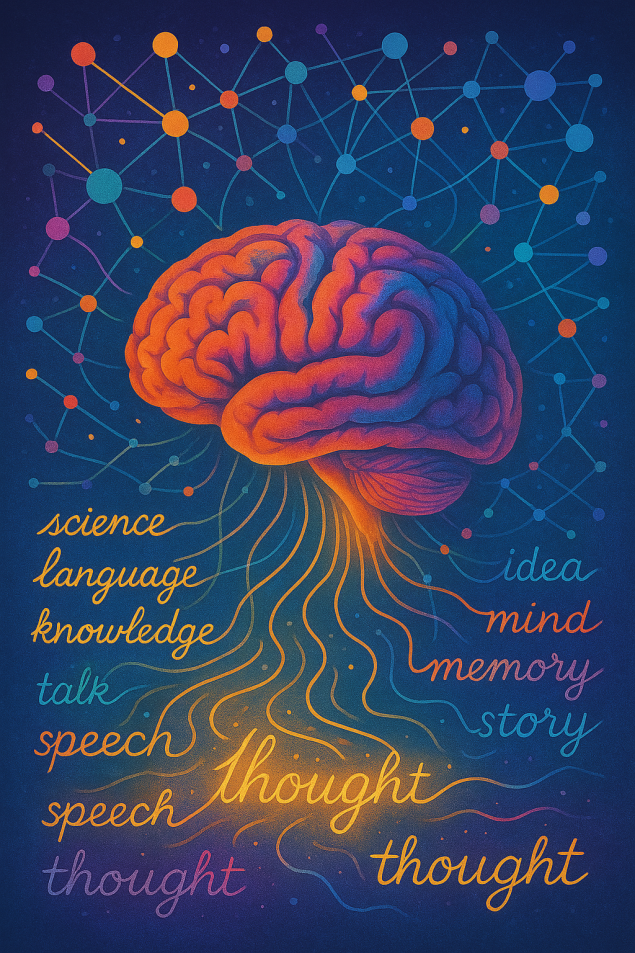279
6 Tips for Learning to Formulate Your Thoughts Faster and More Effectively
Turn the chaos in your head into clear, convincing statements.

Imagine a situation where you know the answer to a question, you understand the problem, but when it comes to explanation, words seem to get stuck somewhere between your brain and your language. Familiar? The inability to quickly and accurately formulate thoughts not only interferes with professional activities, but also creates barriers in personal communication. However, this problem is solvable, and science offers specific methods to overcome it.
Studies show that people who are able to formulate thoughts quickly earn 25% more than their less articulated colleagues.
Why do we get lost in our own thoughts?
Neurobiological aspect
The problem of slow formulation of thoughts lies in the peculiarities of our brain. The Wernicke area, which is responsible for understanding speech, and the Broca area, which controls speech production, must work in sync. When the connection between the two is disrupted due to stress, fatigue, or lack of exercise, the “I know but can’t tell” effect occurs.
Current research in cognitive psychology identifies three main obstacles to effective thought formulation: information overload, lack of thought structure, and insufficient automation of speech skills. Each of these obstacles can be overcome with targeted exercise.
Advice 1: The Reverse Pyramid technique
Essence of method
Start with the main conclusion, then move on to the details. This approach, borrowed from journalism, will revolutionize your ability to formulate thoughts quickly.
Practical exercise: Every day, reading news or books, retell what you read in the format of “the main idea – three key facts – details”. Start with five minutes a day, gradually increasing the time to fifteen minutes.
Maria, the HR director of a large IT company, says: In the past, my presentations lasted forty minutes, and colleagues lost their thread in the fifth minute. After mastering the reverse pyramid technique, I learned to lay down key ideas in the first two minutes. Now they listen to me to the end, and decisions are made twice as fast.

Advice 2: The method of “mental anchors”
Establishment of reference points
Mental anchors are keywords or phrases that help hold the structure of a statement. Professional speakers use them to navigate complex topics without losing a logical thread.
How to apply: Before an important conversation or presentation, write down 3-5 keywords on a leaflet. These words should reflect the main blocks of your message. While speaking, mentally “cling” to these anchors.
Neurolinguistic studies confirm that the use of mental anchors activates additional neural connections in the temporal lobe of the brain, which speeds up the process of extracting the necessary information from long-term memory by 40%.
Advice 3: Technique of the "Word Designer"
This method is based on the principle of modular thinking. Instead of trying to immediately formulate a complex idea as a whole, break it down into simple components-modules, which are then easily assembled into a logical statement.
Action algorithm
Step 1: Define the topic of the statement in one word.
Step 2: Formulate the main idea in one sentence.
Step 3: Add three supporting arguments.
Step 4: End with a conclusion or a call to action.
Example of application: The theme is "Remote work." The main idea is “Remote work increases productivity”. Arguments: “Saving time on the road”, “Comfortable working environment”, “Flexible schedule”. “Companies should develop remote formats of work.”
Advice 4: The development of the "Dictionary Sprint"
Training lexical fluency
The richer your active vocabulary, the faster you find the right words. A dictionary sprint is an intensive training aimed at expanding the active vocabulary and accelerating access to it.
Do the following daily exercise: Take any word and for two minutes write down all the associations, synonyms and related concepts that come to mind. Then try to compose a short story using as many words as possible. This exercise not only expands vocabulary, but also improves the speed of lexical access.

Advice 5: Practice of Instant Interpretation
Development of spontaneous speech
The ability to instantly explain a complex concept in simple words is a sign of deep understanding and developed communication skills. This skill is especially appreciated in a professional environment.
Exercise "Explain to the five-year-old": Every day, choose a difficult term from your professional field and explain it in a way that your child understands. Limitation: No more than three sentences. This causes the brain to search for the most accurate and simple formulations.
Alexander, a leading developer at a fintech startup, shared his experience: I used to get lost in management meetings trying to explain technical solutions. After three months of instant interpretation, I learned to explain blockchain to a person without a technical background in thirty seconds. Now my proposals are more often accepted for implementation. ?
Advice 6: "Emotional anchoring" technique
Emotions are a powerful catalyst for thinking. When you associate information with an emotional state, the speed of its extraction from memory increases significantly. This phenomenon is called emotionally dependent memory.
Creating emotional connections
Before an important performance or a difficult conversation, create a positive emotional background. Think of a time when you felt confident and successful. This emotional tuning activates neural networks associated with successful communication experiences.
Practical application: Keep a journal of successful communication moments. Write down situations where you have articulated your thoughts clearly and convincingly. Regular reading of these records creates stable neural patterns of successful communication.
Research from Stanford University found that people who use emotional anchoring techniques are 60 percent faster at finding the right words in stressful situations.
Integrating methods into everyday life
The effectiveness of the described techniques increases many times with their complex application. Start with one method, bring it to automatism, then add the next. Regularity of practice is critical – it is better to practice for ten minutes every day than for an hour once a week.
Implementation plan for the first 30 days
Days 1-10: Mastering the reverse pyramid technique when retelling news.
Days 11-20: Add mental anchors to working presentations.
Days 21-30: Practicing a word constructor in everyday conversations.
The results will not be long in coming. After just two weeks of regular practice, you’ll notice that words are faster and statements become more structured and persuasive.
The Path to Communication Mastery
The ability to formulate thoughts quickly and accurately is not an innate talent, but a skill that develops through conscious practice. Each of these techniques is based on scientific research and has been tested by thousands of people. Start using them today, and in a month you will be surprised how much the quality of your communication will change.
Glossary
Broca Zone The area of the cerebral cortex responsible for speech production and motor aspects of language. Located in the frontal lobe of the left hemisphere.
Wernicke Zone The area of the cerebral cortex responsible for understanding speech and semantic processing of language information. It's in the temporal lobe.
Cognitive psychology - a section of psychology that studies human cognitive processes: attention, memory, thinking, perception and speech.
Lexical fluency The ability to quickly select and use words from an active vocabulary in the process of speech communication.
Neurolinguistics An interdisciplinary science that studies the relationship between language, brain and human behavior.
Emotionally-dependent memory A phenomenon in which information is better remembered and reproduced in the emotional state in which it was learned.























